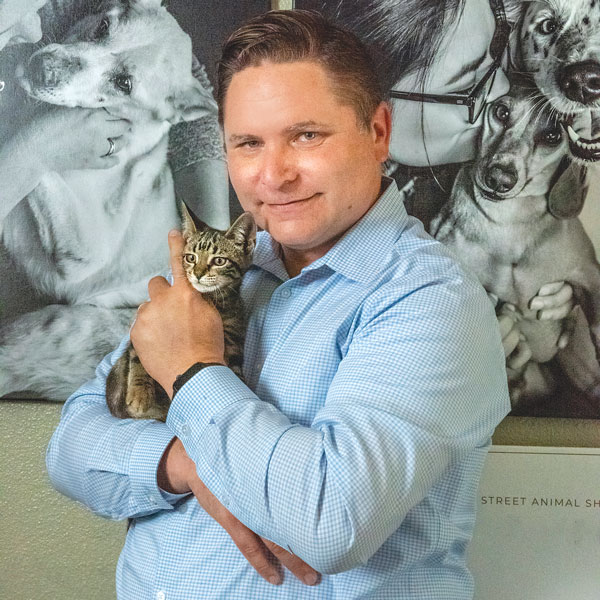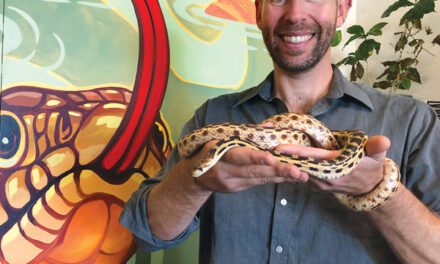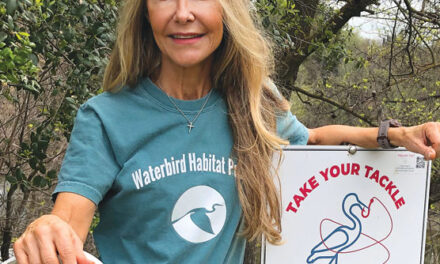Model for Change
New Front Street manager puts emphasis on foster care
By Cathryn Rakich
September 2020
He was four months into his job heading the city’s animal shelter when COVID-19 shut down Sacramento. Phillip Zimmerman joined Front Street Animal Shelter as animal care services manager last November after leading the Stockton Animal Shelter for six years.
“I was running a shelter with the same number of animals, but with a lot less staff,” Zimmerman says of his time in Stockton. “We were doing really great things with a lot less money. So, I thought, I’ll be OK in Sacramento. Then COVID hit.”

Like other businesses, Front Street was forced to shut its doors. Phillip Zimmerman and his team joined other shelters in Sacramento and across the country in quickly moving animals into emergency foster homes. “We moved out over 100 dogs in two days,” he says. Approximately 20 cats also were relocated.
Six months later, Front Street is up and running again—taking in strays and conducting adoptions, all by appointment to ensure the safety of staff and community. But the foster-centric model is at the forefront. The majority of healthy animals are placed into foster homes within hours or days of arrival. The shelter keeps ill, injured and dangerous pets not suited for foster care.
Phillip Zimmerman replaced former—and popular—animal care services manager Gina Knepp, who retired in October. “I don’t have Gina’s personality. I’m a little more reserved,” Zimmerman says. “She is a bigger risk-taker than I am. As far as the sheltering part, I think I bring a lot to the table.”
Born in Sacramento, Zimmerman earned his bachelor’s degree in social science at California State University, Stanislaus, and joined the Stockton Police Dispatch Department as a 911 dispatcher in 1997. He was eventually promoted to supervisor.
After 18 years with dispatch, he needed a change. “I was tired of being stuck in a room,” Zimmerman says. When the manager position for the Stockton Animal Shelter came up, he was reluctant. “I saw the position advertised and I said, ‘I’m not going to go work at the pound.’”
But with encouragement from a friend at the shelter, Phillip Zimmerman decided to apply. Despite his lack of animal care experience, he had 18 years in law enforcement, including handling animal-related 911 calls after shelter hours.
“I get out there and wow. They had a partnership with the San Francisco SPCA. And they were doing great stuff. I thought, I can do this,” he says.
Zimmerman was hired Jan. 1, 2015, and quickly produced results. He boosted the volunteer program, hired a shelter volunteer coordinator, held community adoption and fundraising events, and applied for more grants.
What enticed Zimmerman to seek the head position at Front Street Animal Shelter when Knepp left? “I blame it on Gina because she was on my hiring panel in Stockton. From that day, Gina and I were friends,” Zimmerman says. In addition to Knepp’s influence, Zimmerman has extended family in Sacramento. Plus, “Sacramento has a lot more resources,” he says.
Knepp came to Front Street with a similar background—20 years with the Sacramento Police Department 911 call center. During the Stockton interview, “Gina told me it’s a heart-wrenching job,” Zimmerman recalls. “It’s emotionally charged—sometimes for good reasons, sometimes for bad reasons. I told them I’ve been on the phone when people have been shot or a parent has lost their child. I’ve dealt with all of these things on the phone.
“Gina said, ‘Just so you know, this job is going to be way tougher.’ And she was 100 percent correct. When you are on the phone, you have the ability to compartmentalize. But when you are looking at animals that can’t speak, and humans are making decisions for them, that’s difficult.”
Zimmerman and his husband live in Fair Oaks with “one very old cat,” two Yorkies and two Chihuahua mixes. “Chihuahuas are always mixed with something,” Zimmerman laughs.
One of the dogs is a recent adoption from Front Street. “Right before the first shelter-in-place order, a social worker came in with a homeless man. They were trying to convince him to get off the streets. But he didn’t want to get rid of his dog. I said, ‘Look, I’ll foster the dog. When you get in your housing, you can have the dog back.’”
The gentleman finally found housing, but couldn’t take the dog. “She slept in a kennel in our bedroom at first. That lasted about two weeks. Now she sleeps on the bed with us. She loves everybody. She was living in a homeless encampment. She got to know everyone.”
Despite more overall resources in Sacramento, the Stockton shelter had more medical staff, which is why Zimmerman’s vision for Front Street includes a larger medical team. “It’s challenging when you don’t have a robust veterinary team,” Zimmerman says. “They’re the core. Animals have to receive medical treatment.”
A second vision for Front Street is access to affordable veterinary care. “I have no doubt that a lot of the stray and injured animals that end up here are owned animals, because owners cannot afford veterinary care,” Zimmerman says.
The third goal is to make the foster-care model work. “I’m seeing the benefits,” he says. “Animals are leaving healthier. They are getting adopted. We’re not going to have everything figured out in animal welfare right now. But is there a better way to do it? I am cautiously optimistic that this is the future of animal sheltering.”
If you find a pet, text FOUNDPET to 555888 for tips to find the owner. If you can’t care for the animal, call 311 to discuss possible options and/or schedule an appointment to drop off the pet at the city or county shelter. For more information on what to do if you find a stray, visit sspca.org/letstalkstrays.
Is ‘Foster’ vs. ‘Shelter’ a Model for the Future?
The city’s Front Street Animal Shelter has embraced a “foster” over “shelter” model, which was gaining nationwide popularity before the pandemic. But the foster-centric program has led to controversy.
Critics question why the public is put in the position of doing a municipal shelter’s work. How can staff provide the necessary amount of support to Front Street’s 200-plus foster homes? How do employees adequately screen potential foster parents? How do they keep track of the more than 400 animals—the majority being litters of kittens—in the foster system?
Pre-COVID, “our animal care technicians were spending five to six hours a day cleaning kennels,” says Phillip Zimmerman, animal care services manager for Front Street. Now, with a robust foster system, staff has more time to assist in other areas. “We trained all the staff to support the foster program because we should all be involved in programs like this.”
A national coalition, Human Animal Support Services, promotes community collaboration to reimagine the traditional model of animal services by housing most pets in homes, not kennels. Twelve organizations are participating in the pilot program, including shelters in Fresno, Oakland, Los Angeles and San Diego. Gina Knepp, former manager of Front Street Animal Shelter, is on the HASS leadership team.
Under this model, the core functions of the physical shelter are to provide emergency medical care and short-term housing for pets with urgent needs. Front Street continues to house ill, injured and dangerous animals.
“I’m a big fan of the idea and I think it could really be a game-changer in sheltering,” says attorney Jim Houpt, longtime Front Street volunteer and president of Friends of Front Street, the city shelter’s nonprofit arm.
Kelli Lorenz began fostering dogs for Front Street in May. “Obviously, there are some dogs that are not going to be able to be fostered,” she says. “But when dogs can be in a house, that’s so much better.”
Sheri Achterberg has been fostering dogs for Front Street for six years. “For the dog’s sake, it’s way better. They’re in a home. They’re comfortable. They have socialization.” Both Lorenz and Achterberg report that Front Street staff have been responsive and helpful with supplies, medical needs and the adoption process.
“The shelter is the worst possible place to bring dogs,” Houpt adds. “A lot of our dogs develop behavior issues just in reaction to the shelter environment. The best of all possible worlds is getting dogs in and getting them into a home immediately.”
“Organizations are not opening their doors to go back to the way things were,” Zimmerman says. “We would be remiss to animals, to people, to taxpayers, to our staff who work in the shelters, if we didn’t give this new model a try.”
For more information, visit humananimalsupportservices.org.
Cathryn Rakich can be reached at crakich@surewest.net. Follow us on Facebook, Twitter and Instagram: @insidesacramento.















